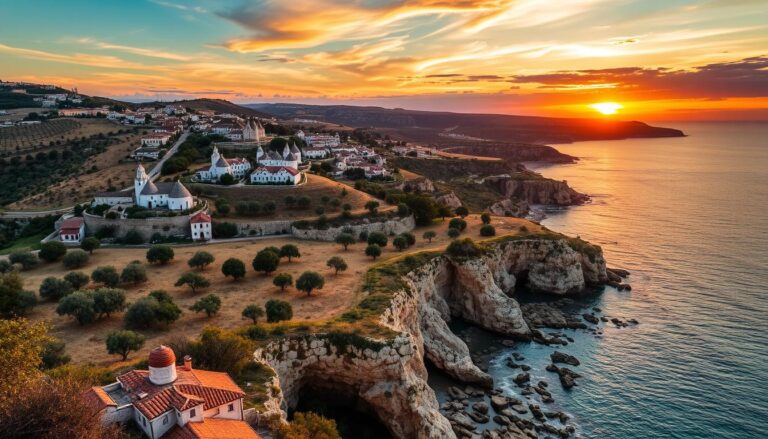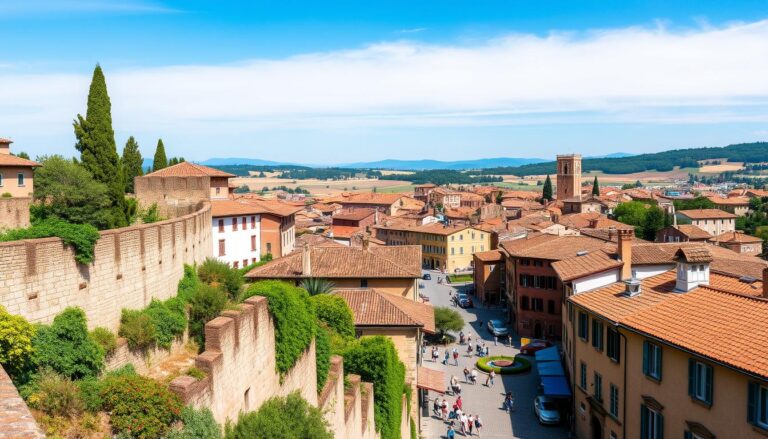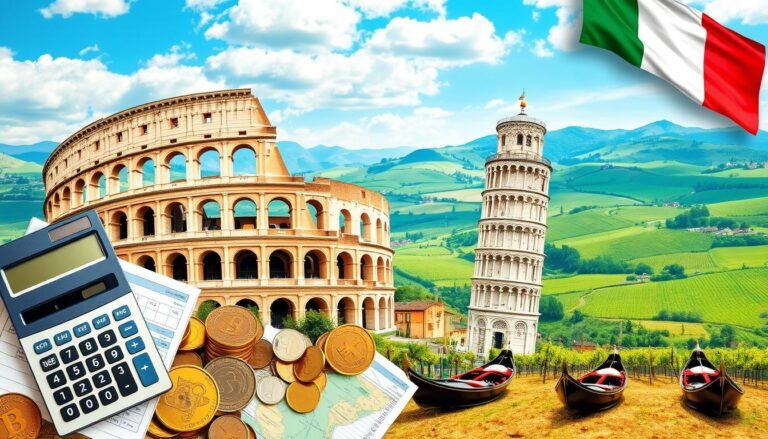Murano Island: A Captivating Glass-Blowing Destination
Imagine stepping onto a small island where molten glass turns into stunning art right before your eyes. Murano Island, in the Venetian Lagoon, welcomes visitors with its long history of glassmaking. This tradition has amazed both artisans and tourists since the 13th century.
With only 7,000 people living there, Murano Italy is a close look at where skill meets magic. It’s the second-largest island in the lagoon. This place is famous for its glass art, attracting fans from everywhere to see its rich culture.
Your trip to Murano Island is more than just seeing sights. It’s a deep dive into a world of glass artistry. Here, skilled craftsmen carry on a tradition that’s been passed down for generations. Each piece, from detailed decorations to useful keepsakes, shares a tale of talent, love, and creativity.
Whether you love art, want to explore culture, or just enjoy unique crafts, Murano Island is a journey into Italy’s artistic soul. Get ready to be amazed by the beauty of molten glass and the incredible talent of its makers.
Table of Contents
What is Murano Island?
Murano Island is a gem in the Venetian Lagoon. It’s known for its artistic genius and long history of craftsmanship. This small island has amazed many with its stunning Murano glass history and rich culture.
Just a short boat ride from Venice, Murano has been key in glassmaking since the Middle Ages. A decree by the Venetian Senate in 1201 made it a world leader in glass art.
A Brief Historical Overview
Murano’s glassmaking roots are in Venetian tradition. In 1291, the Venetian Republic moved all glassmakers to Murano to avoid fires in Venice. This move protected Venice and brought together incredible glassmaking talent.
- Peak population reached up to 30,000 inhabitants
- Home to sixteen historic churches
- Developed intensive glassworks after Senate decree
Location and Accessibility
Getting to Murano is easy by vaporetto (water bus) from Venice. It’s just 10 minutes away, perfect for a day trip. The island is 1.5 kilometers long and can be explored on foot in 20 minutes.
The island’s charm lies in its narrow canals, historic glass workshops, and the lasting tradition of glass artistry. This tradition has shaped Murano for centuries.
The Art of Glass-Blowing
Murano glass making is a centuries-old craft that turns simple materials into amazing art. The island’s glassblowing tradition goes back to the 10th century. It has created a legacy of unmatched craftsmanship that still amazes artists and visitors today.
Exploring Murano glass blowing opens a world of skill and creativity. The process uses techniques passed down through generations of master artisans.
Essential Techniques and Tools
- Gathering molten glass from furnaces heated to 2,000 degrees Fahrenheit
- Using specialized blowpipes to shape and manipulate glass
- Applying precise heating and cooling methods
- Implementing traditional coloring and decorative techniques
Understanding the Glass-Blowing Process
Murano glass making involves several key steps that need great skill and patience. Artisans start by picking high-quality silica sand and mixing it with minerals for unique colors and textures.
| Stage | Description | Temperature Range |
|---|---|---|
| Melting | Raw materials transformed into liquid glass | 1,000-1,300°C |
| Shaping | Glass blown and manipulated using specialized tools | 700-900°C |
| Cooling | Gradual temperature reduction to prevent cracking | 20-500°C |
Each piece of Murano glass is a unique artistic expression. It shows centuries of refined technique and creative innovation.
Visiting Murano Island
Murano Italy is a special place that offers more than just a typical tourist trip. It’s a short boat ride from Venice. Here, you can see the art of glass-making and learn about the island’s rich culture.
Planning Your Perfect Trip
Timing is key when visiting Murano island. The best times are late spring (May-June) and early autumn (September-October). These periods have fewer crowds and nice weather, perfect for exploring the island’s glass traditions.
What to Expect During Your Visit
A visit to Murano usually includes seeing glass workshops and museums. Plan for a half-day trip. This gives you enough time to see the island’s main attractions.
- Visit active glass foundries
- Explore the Glass Museum (Museo del Vetro)
- Watch live glass-blowing demonstrations
- Purchase unique glass souvenirs
Travel and Accommodation Tips
Most people get to Murano from Venice by ferry. There are many ways to get there. If you want to really experience the island, stay overnight.
| Trip Detail | Information |
|---|---|
| Ferry Ticket Cost | €24 for 24-hour pass |
| Ferry Operating Hours | 6 am to 10:30 pm |
| Travel Time from Venice | 40-50 minutes |
Pro tip: Arrive early in the morning to beat the crowds. Enjoy a peaceful visit to this magical place.
Famous Glass-Makers
Murano glass is a masterpiece of art that has amazed people for centuries. The island’s glass-making history goes back over a thousand years. Venetian glass masters keep alive the detailed techniques passed down through generations.

The tradition of Venetian glass has led to many famous studios and artists. They have shaped how the world sees glass art. Their dedication to quality keeps Murano at the top of glass-making.
Renowned Glass Studios to Explore
When you visit Murano, you’ll find amazing glass studios. These places show the island’s artistic talent. Some top places include:
- Gino Mazzuccato Glass Factory (founded in 1958)
- Venini Glass Factory
- Barovier & Toso Historical Workshop
Learning from the Masters
Murano lets you see glass-making artistry up close. You can join workshops to learn from experts. They show you how to make Venetian glass.
| Studio | Workshop Duration | Experience Level |
|---|---|---|
| Gino Mazzuccato | 40 minutes | Beginner to Advanced |
| Venini | 60 minutes | Intermediate |
| Barovier & Toso | 90 minutes | Advanced |
By learning from these masters, you’ll see the authentic techniques of Murano glass. It’s a global symbol of artistic excellence.
The Unique Products of Murano Glass
Murano glass is a true art form that turns molten glass into stunning works. For centuries, the island’s glassmakers have honed their skills. They create pieces that amaze and show their incredible talent.
Stunning Glass Artworks
Exploring Murano glass reveals a wide range of artistic expressions. These masterpieces show off the artisans’ skill in different forms:
- Intricate hand-blown sculptures
- Delicate figurines with vibrant colors
- Elaborate Murano chandeliers
- Complex decorative objects
Practical Items and Souvenirs
Murano glass isn’t just for show. You can also find useful and memorable items to take home:
- Elegant drinking glasses
- Decorative vases
- Unique jewelry pieces
- Small ornamental objects
Every Murano glass piece has a Trademark of Origin to prove its authenticity. The island’s glassmakers follow strict standards. This ensures each piece reflects their long history of skill and artistry.
| Product | Dimensions | Price |
|---|---|---|
| MARLEY Peace Sign Sculpture | 27 cm Height | $750.00 |
| NOBILITY Royal Couple | 50 cm Height | $1,425.00 |
| GALAXY Glass Spiral | 52 cm Height | $1,000.00 |
Looking for a beautiful Murano chandelier or a small keepsake? These glass treasures have something for everyone, no matter your budget.
Cultural Significance of Murano Glass
Murano glass is more than just a craft. It’s a blend of art and history that has amazed people for centuries. It shows the deep cultural roots of Venice, mixing old traditions with new ideas.
The history of Murano glass goes back to the 13th century. At that time, Venice moved its glassmaking to Murano Island. This move was smart for two reasons: it kept trade secrets safe and reduced fire risks in the crowded city.
Heritage and Tradition
Venetian glassmakers were known for their unique skills. They used special techniques like:
- Filigrana: Intricate glass threading technique
- Sommerso: Layered glass with three-dimensional effects
- Millefiori: Complex floral-like glass patterns
- Lattimo: Milk-white glass production
Influence on Art and Design
Murano glass went beyond being just a craft. It became a big part of European art and design. Its beauty and skill inspired many artists and designers.
| Century | Artistic Significance |
|---|---|
| 15th-16th | Golden Age of Venetian Glass Production |
| 18th | International Design Influence |
| 20th | Modern Art and Design Revival |
Today, Murano glass is still a symbol of artistic excellence. It connects old skills with new designs. Each piece shares a tale of creativity, skill, and keeping traditions alive.
How to Get to Murano Island
Exploring Murano Island is an exciting journey. It starts with knowing how to get there. This glass-making paradise is just 3.5 kilometers north of Venice. It’s easy to reach through several paths.
Traveling from Venice
The best way to get to Murano Island is by vaporetto. Venice’s public water bus system has several lines to this beautiful place:
- Line 4.1 and 4.2: Direct routes to Murano
- Line 12 and 13: Alternative connections
- Night water bus (Line N): Evening transportation
Transportation Options and Travel Times
Travel times to Murano vary based on where you start in Venice:
| Starting Location | Travel Time | Line |
|---|---|---|
| Fondamenta Nove | 9 minutes | 4.1, 4.2 |
| Piazzale Roma | 34 minutes | 3 |
| St. Mark’s Square | 43 minutes | 4.1, 4.2 |
Alternative Transportation
Water taxis offer a private ride. But, they cost a lot more:
- Minimum fare: 60 euros (up to 4 passengers)
- Additional passenger: 10 euros each
- Luggage fees: 10 euros first piece, 3 euros for each additional piece
Pro tip: Get a multi-day transport pass to save money. The Rolling Venice Pass is a great deal for island explorers.
Guided Tours and Workshops
Explore the magical world of Murano glass making through guided tours and workshops. These experiences let you see the detailed techniques that have made Murano famous. You’ll get to see how this ancient craft is still alive today.

There are many tour options to choose from. Each one shows you the art of glass creation in a unique way:
- Private glass-blowing demonstrations
- Half-day and full-day tour experiences
- Expert-guided factory visits
- Hands-on glass-making workshops
What’s Offered for Visitors
The guided tours dive deep into Murano glass making. Most tours include:
| Tour Feature | Details |
|---|---|
| Maximum Group Size | 20 guests |
| Tour Duration | 5 hours |
| Daily Tour Times | 09:00 & 13:30 |
| Average Price | US$291.04 per adult |
Learning Opportunities for You
Want to try making Murano glass yourself? Many workshops let you:
- Watch master artisans demonstrate traditional glass-blowing methods
- Learn about the history of glass making on the island
- Create your own small glass artwork under expert guidance
Remember, tours have specific rules. The experience is not wheelchair accessible, and there’s a 24-hour cancellation policy. With a 96.15% excellent review rating, these tours offer a unique look into Murano glass craftsmanship.
Dining on Murano Island
Murano Italy is known for more than just glass-making. Its restaurants mix traditional Venetian tastes with fresh seafood. This creates a unique dining experience that shows the island’s rich maritime culture.
Exploring Murano’s food scene lets you taste authentic local dishes. These dishes capture the heart of Venetian cooking. The island’s eateries use fresh, local ingredients to honor the region’s sea heritage.
Local Culinary Delights
In Murano Italy, you’ll find amazing dishes that celebrate the area’s seafood:
- Pasta al Nero di Seppia (pasta with black squid ink)
- Risotto di Gó (local fish risotto)
- Gnocchi with scallops
- Grilled seafood platters
Recommended Restaurants
Here are some top places to eat on the island:
- Da Primo: Offers vegetarian dishes and traditional Venetian meals
- Ai Piantaleoni: Price range €60 – €80
- Local seafood restaurants with fresh catch of the day
Pro tip: Book your table early, as spots fill up fast. Lunch is from 11:30 AM to 3:30 PM. Dinner is from 6:30 PM to 9:00 PM.
Shopping for Murano Glass
Exploring Venice’s market for authentic Murano glass is exciting. You’ll learn how to spot genuine Venetian glass. This involves knowing where to buy and how to recognize quality.
Where to Buy Authentic Pieces
For real Murano glass, stick to trusted places. Look for shops and galleries with the “Vetro Artistico Murano” mark. This is the sign of true Murano glass.
- Official Murano glass galleries on the island
- Specialized Venice glass shops
- Certified artisan workshops
- Recommended museum gift stores
Tips for Choosing Quality Glass
Finding top-notch Murano glass needs a keen eye. Look for signs of real craftsmanship and unique features. These are what make authentic pieces stand out.
| Quality Indicator | What to Look For |
|---|---|
| Trademark | “Vetro Artistico Murano” certification |
| Price Range | $69.63 to $721.27 |
| Typical Dimensions | 8.5 × 10.0 cm to 20.0 × 16.0 cm |
| Design Characteristics | Transparent luminosity, vivid colors, intricate patterns |
Buying authentic Murano glass helps local artists and keeps a long tradition alive. It’s more than just a purchase. It’s a way to support culture.
Pro tip: Book special shopping sessions with famous glass makers. They offer private tours and a peek into the artisans’ world.
Events and Festivals on Murano Island
Murano Island is filled with life during cultural celebrations. These events show off the island’s glass-making history. Visitors can enjoy unique experiences that celebrate the island’s artistic traditions.
Annual Celebrations to Explore
The Venice Glass Week is a major event on Murano’s calendar. It takes place from September 14 to 22, 2024. Since 2017, it has been a key celebration of Murano glass art.
Some events you should not miss include:
- Venice Glass Week festival
- Special exhibitions at historic glass factories
- Saint Nicholas Day celebration on December 6th
Special Workshops and Exhibitions
Murano Island is a great place to learn about glass art. The Glasstress 8½ exhibition showcases 30 works by famous artists. It offers a close look at modern glass craftsmanship.
| Event | Date | Highlights |
|---|---|---|
| Venice Glass Week | September 14-22, 2024 | 9-day glass art festival |
| Glasstress 8½ Exhibition | 2024 | 30 artistic glass works |
| Convito di Vetro Exhibition | 2024 | Entrance fee: 15 euros |
These events are perfect for those who love Murano glass. They let you see the skill of local artisans and learn about the craft’s cultural importance.
Whether you love glass art or just want to learn about Murano’s tradition, these events are unforgettable. They bring the island’s creative spirit to life.
Preserving the Murano Glass Legacy
The art of Murano glass has faced many challenges over the centuries. These include theft of trade secrets and competition from industrial methods. Understanding this craft shows a deep cultural heritage tied to Venice’s history.
Murano glass techniques have shown great resilience. They have survived through many changes, keeping an extraordinary artisan tradition alive.
Today, the glass industry faces big challenges. Environmental worries and energy crises threaten its future. Young people on the island are looking for ways to make production more sustainable.
The COVID-19 pandemic has also hit the industry hard. It has made the economic situation very delicate.
Challenges Facing the Industry
Making authentic Murano glass is a strict process. Each piece must be made only on the island. It uses high-quality materials like silica sand and special metal oxides.
The industry needs to attract more young artisans. It must keep the centuries-old Murano glass history alive. This ensures the intricate techniques are not lost forever.
Efforts to Sustain the Craft
Programs and educational efforts are starting to protect this unique craft. Contemporary artists are working with traditional glassmakers. This helps bridge the gap between old and new knowledge.
Supporting authentic certification and promoting handcrafted Murano glassware is key. These efforts aim to keep alive a remarkable artistic legacy that has lasted since the 8th century.







